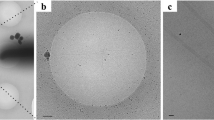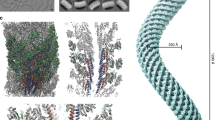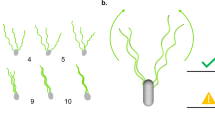Abstract
Bacterial motility involves switching between the left and right supercoiled states of the flagellar filament. The polymorphism of this assembly of identical flagellin molecules has presented a structural puzzle. Supercoiling has been attributed to coexistence of two conformational states of the 11 nearly axially aligned protofilament strands of subunits. The helical parameters of straight filaments in the left (L) and right (R) lattice states have now been accurately determined by X-ray fiber diffraction. The 9 Å resolution electron density map of the R-type filament, refined from the X-ray data, reveals the interlocked α-helical segments of the core portion, which constitute the inner and outer tubes. While the inner-tube domain interactions remain invariant, the strand joints in the outer tube can switch between the L- and R-state by 2–3 Å axial shifts, which change the strand periodicity of ∼50 Å by 0.8 Å. This bi-stable quaternary switching results in supercoiling. Based on the measured helical parameters of the L and R lattices and the switching model, the twist and curvature calculated for the ten possible supercoils are in quantitative accord with observed supercoiled forms of flagellar filaments.
This is a preview of subscription content, access via your institution
Access options
Subscribe to this journal
Receive 12 print issues and online access
$189.00 per year
only $15.75 per issue
Buy this article
- Purchase on Springer Link
- Instant access to full article PDF
Prices may be subject to local taxes which are calculated during checkout
Similar content being viewed by others
References
Berg, H.C. & Anderson, R.A. Bacteria swim by rotating their flagellar filaments. Nature 245, 380–382 (1973).
Silverman, M. & Simon, M. Flagellar rotation and the mechanism of bacterial motility. Nature 249, 73–74 (1974).
Larsen, S.H., Reader, R.W., Kort, E.N., Tso, W.W. & Adler, J. Change in direction of flagellar rotation is the basis of the chemotactic response in Escherichia coli. Nature 249, 74–77 (1974).
Macnab, R.M. & Ornston, M.K. Normal-to-curly flagellar transitions and their role in bacterial tumbling, stabilization of an alternative quaternary structure by mechanical force. J. Mol. Biol. 112, 1–30 (1977).
Leifson, E. Atlas of bacterial flagellation. (Academic Press, New–York; 1960).
lino, T. & Mitani, M. Flagella-shape mutants in Salmonella. J. Gen. Microbiol. 44, 27–40 (1966).
Martinez, R.J., Ichiki, A.T., Lundh, N.P. & Tronick, S. R. Single amino acid substitution responsible for altered flagellar morphology. J. Mol. Biol. 34, 559–564 (1968).
Asakura, S. & lino, T. Polymorphism of Salmonella flagella as investigated by means of in vitro copolymerization of flagellins derived from various strains. J. Mol. Biol. 4, 251–268 (1972).
lino, T., Oguchi, T. & Kuroiwa, T. Polymerization in flagellar-shape mutants of Salmonella typhimurium. J. Gen. Microbiol. 81, 37–45 (1974).
Hyman, H.C. & Trachtenberg, S. Point mutations that lock Salmonella typhimurium flagellar filaments in the straight right-handed and left-handed form and their relationship to filament superhelicity. J. Mol. Biol. 220, 79–88 (1991).
Kanto, S., Okino, H., Aizawa, S.-l. & Yamaguchi, S. Amino acids responsible for flagellar shape are distributed in terminal regions of flagellin. J. Mol. Biol. 219, 471–480 (1991).
Kamiya, R. & Asakura, S. Helical transformations of Salmonella flagella in vitro. J. Mol. Biol. 106, 167–186 (1976).
Kamiya, R. & Asakura, S. Flagellar transformations at alkaline pH. J. Mol. Biol. 108, 513–518 (1977).
Hotani, H. Micro-video study of moving bacterial flagellar filaments III. Cyclic transformation induced by mechanical force. J. Mol. Biol. 156, 791–806 (1982).
ÓBrien, E.J. & Bennett, P.M. Structure of straight flagella from a mutant Salmonella. J. Mol. Biol. 70, 133–152 (1972).
Asakura, S. Polymerization of flagellin and polymorphism of flagella. Advan. Biophys. 1, 99–155 (1970).
Calladine, C.R. Construction of bacterial flagella. Nature 225, 121–124 (1975).
Calladine, C.R. Design requirements for the construction of bacterial flagella. J. Theoret. Biol. 57, 469–489 (1976).
Calladine, C.R. Change of waveform in bacterial flagella: The role of mechanicsat the molecular level. J. Mol. Biol. 118, 457–479 (1978).
Kamiya, R., Asakura, S., Wakabayashi, K. & Namba, K. Transition of bacterial flagella from helical to straight forms with different subunit arrangements. J. Mol. Biol. 131, 725–742 (1979).
Kamiya, R., Asakura, S. & Yamaguchi, S. Formation of helical filaments by copolymerization of two types of ‘straight’ flagellins. Nature 286, 628–630 (1980).
Mimori, Y. et al. The structure of the R-type straight flagellar filament of Salmonella at 9 Å resolution by electron cryomicroscopy. J. Mol. Biol. 249, 69–87 (1995).
Morgan, D.G., Owen, C., Melanson, L A. & DeRosier, D. J. Structure of bacterial flagellar filaments at 11 Å resolution: Packing of the α-helices. J. Mol. Biol. 249, 88–110 (1995).
Mimori-Kiyosue, Y., Vonderviszt, F., Yamashita, I., Fujiyoshi, Y. & Namba, K. Direct interaction of flagellin termini essential for polymorphic ability of flagellar filament. Proc. Natl. Acad. Sci. USA. 93, 15108–15113 (1996).
Vonderviszt, F., Kanto, S., Aizawa, S.-l. & Namba, K. Terminal regions of flagellin are disordered in solution. J. Mol. Biol. 209, 127–133 (1989).
Mimori-Kiyosue, Y., Vonderviszt, F. & Namba, K. Locations of terminal segments of flagellin in the filament structure and their roles in polymorphism and polymerization. J. Mol. Biol. 270, 222–237 (1997).
Vonderviszt, F., Aizawa, S.-l. & Namba, K. Role of the disordered terminal regions of flagellin in filament formation and stability. J. Mol. Biol. 221, 1461–1474 (1991).
Yamashita, I., Vonderviszt, F., Noguchi, T. & Namba, K. Preparing well-oriented sols of straight flagellar filaments for X-ray fiber diffraction. J. Mol. Biol. 217, 293–302 (1991).
Namba, K., Yamashita, I. & Vonderviszt, F. Structure of the core and central channel of bacterial flagella. Nature 342, 648–654 (1989).
Yamashita, I. et al. Radial mass analysis of the flagellar filament of Salmonella: Implications for subunit folding. J. Mol. Biol. 253, 547–558 (1995).
Namba, K. & Stubbs, G. Solving the phase problem in fiber diffraction. Application to tobacco mosaic virus at 3.6 Å resolution. Ada Crystallogr. A41, 252–262 (1985).
Namba, K. & Vonderviszt, F. Molecular architecture of bacterial flagellum. Quart Rev. Biophys. 30, 1–65 (1997).
Makowski, L. Processing of X-ray diffraction data from partially oriented specimens. J. Appl. Crystallogr. 11, 273–283 (1978).
Hasegawa, K., Yamashita, I. & Namba, K. Quasi- and non-equivalence in the structure of bacterial flagellar filament. Biophys. J. in the press.
Kamiya, R., Hotani, H. & Asakura, S. Polymorphic transition in bacterial flagella. Symp. Soc. Exp. Biol. 35, 53–76 (1985).
Author information
Authors and Affiliations
Rights and permissions
About this article
Cite this article
Yamashita, l., Hasegawa, K., Suzuki, H. et al. Structure and switching of bacterial flagellar filaments studied by X-ray fiber diffraction. Nat Struct Mol Biol 5, 125–132 (1998). https://doi.org/10.1038/nsb0298-125
Received:
Accepted:
Published:
Issue Date:
DOI: https://doi.org/10.1038/nsb0298-125
This article is cited by
-
Flagellin-based electrochemical sensing layer for arsenic detection in water
Scientific Reports (2021)
-
Geometrical Constraints on the Tangling of Bacterial Flagellar Filaments
Scientific Reports (2020)
-
Bacterial coexistence driven by motility and spatial competition
Nature (2020)
-
The wild-type flagellar filament of the Firmicute Kurthia at 2.8 Å resolution in vivo
Scientific Reports (2019)
-
Hooked on motility
Nature Structural & Molecular Biology (2019)



